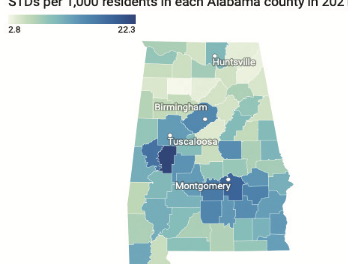The Birmingham Museum of Art continues to expand its collection of African American art with the purchase of Joshua Johnson’s Portrait of Elizabeth Gilpin (1804–1892). (File)
” data-medium-file=”https://www.birminghamtimes.com/wp-content/uploads/2024/03/BMA-1–300×175.png” data-large-file=”https://www.birminghamtimes.com/wp-content/uploads/2024/03/BMA-1-.png” />
artsbma.org
” data-medium-file=”https://www.birminghamtimes.com/wp-content/uploads/2024/03/BMA-2-245×300.jpg” data-large-file=”https://www.birminghamtimes.com/wp-content/uploads/2024/03/BMA-2-835×1024.jpg” class=” wp-image-118643″ src=”https://www.birminghamtimes.com/wp-content/uploads/2024/03/BMA-2.jpg” alt=”” width=”278″ height=”341″ srcset=”https://www.birminghamtimes.com/wp-content/uploads/2024/03/BMA-2.jpg 1958w, https://www.birminghamtimes.com/wp-content/uploads/2024/03/BMA-2-245×300.jpg 245w, https://www.birminghamtimes.com/wp-content/uploads/2024/03/BMA-2-835×1024.jpg 835w, https://www.birminghamtimes.com/wp-content/uploads/2024/03/BMA-2-768×941.jpg 768w, https://www.birminghamtimes.com/wp-content/uploads/2024/03/BMA-2-1253×1536.jpg 1253w, https://www.birminghamtimes.com/wp-content/uploads/2024/03/BMA-2-1671×2048.jpg 1671w, https://www.birminghamtimes.com/wp-content/uploads/2024/03/BMA-2-343×420.jpg 343w, https://www.birminghamtimes.com/wp-content/uploads/2024/03/BMA-2-640×784.jpg 640w, https://www.birminghamtimes.com/wp-content/uploads/2024/03/BMA-2-681×835.jpg 681w” sizes=”(max-width: 278px) 100vw, 278px” />
The Birmingham Museum of Art continues to expand its collection of African American art with the purchase of Joshua Johnson’s Portrait of Elizabeth Gilpin (1804–1892). Johnson, widely recognized as the first professional African American painter known to have worked in the United States, spent his career representing early nineteenth-century American life through his masterful portraiture. The painting is now on view in the BMA’s Styslinger Gallery of American Art.
“Acquiring this portrait is a testament to our continued commitment to presenting a more inclusive and comprehensive narrative of American art history,” says Dr. Graham C. Boettcher, The R. Hugh Daniel Director of the Birmingham Museum of Art. “Joshua Johnson’s work adds a crucial layer to our understanding of the diverse talents and perspectives that shaped our nation’s cultural landscape.”
Born into slavery, Johnson’s journey to becoming a self-taught professional portrait painter was unprecedented. After gaining his freedom in 1782, Johnson established himself in Baltimore, Maryland, at that time a flourishing hub of trade. He resided in the city’s Fells Point neighborhood, populated by Quakers, abolitionists, and free people of color.
From 1803 to 1815, he produced the majority of his known portraits, fewer than 100 of which survive portraying a diverse range of individuals, often including children. Johnson’s unique perspective on race and societal roles in the early United States remains a critical aspect of his artistic legacy.
Johnson painted Elizabeth Gilpin around 1814, when she was about 10 years old. The portrait reflects the artist’s distinctive, straightforward style in Gilpin’s direct gaze and the careful attention paid to capturing the textures of fabrics she wore.
A member of a prominent Quaker family from Philadelphia, Gilpin is depicted holding a letter, seated on a simple Windsor side chair. Her father, Joshua Gilpin (1765–1841) founded the first paper mill in Delaware on the Brandywine River in 1787. Elizabeth Gilpin’s family connection to the Quaker community adds depth to the narrative, as Johnson often painted abolitionist sympathizers and their families, and
Philadelphia’s Quaker community also often supported anti-slavery efforts. Dr. Katelyn D. Crawford, The William Cary Hulsey Curator of American Art at the BMA, said: “The acquisition of Portrait of Elizabeth Gilpin at the BMA helps to fill a critical gap in the museum’s collection, allowing for the exploration of new stories about race and childhood in early America.”
This acquisition comes after years of dedicated efforts by the BMA to expand its collection of African American art from the nineteenth century. In 1988, the BMA hosted the exhibition Sharing Traditions: Five Black Artists in 19th-Century America, exploring the lives and work of Johnson, Robert S. Duncanson, Edward Mitchell Bannister, Edmonia Lewis, and Henry Ossawa Tanner, five of the best-known African American artists of the nineteenth century.
At the time, Tanner was the only one of the five represented in the Museum’s collection. Now important works by each of these five artists anchor the Museum’s historic American art collection.
Founded in 1951, the Birmingham Museum of Art has one of the finest collections in the Southeast. More than 27,000 objects displayed and housed within the Museum represent a rich panorama of cultures, including Asian, European, American, African, Pre-Columbian, and Native American. Highlights include the Museum’s collection of Asian art, Vietnamese ceramics, the Kress collection of Renaissance and Baroque paintings, sculpture, and decorative arts from the late 13th century to the 1750s, and the Museum’s world-renowned collection of Wedgwood, the largest outside of England.











